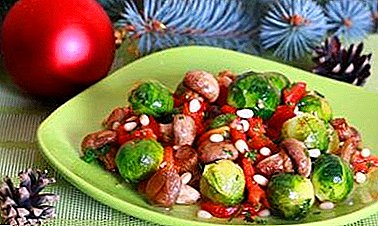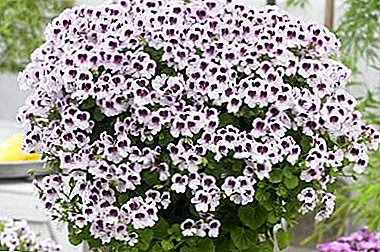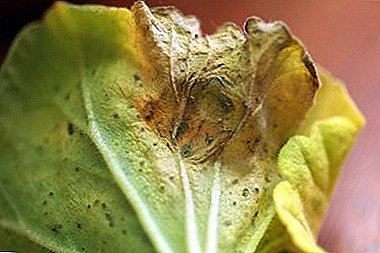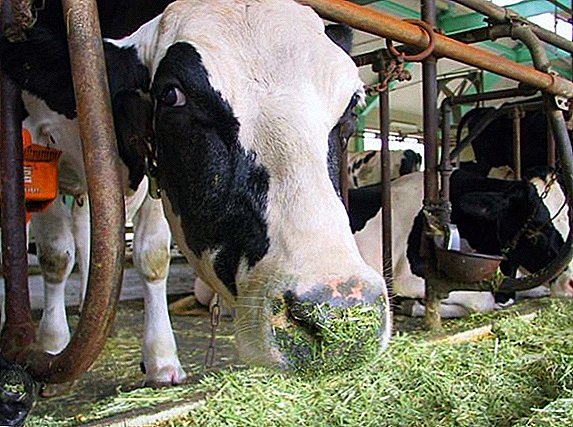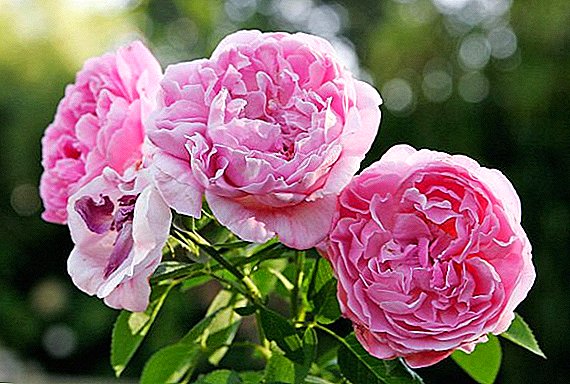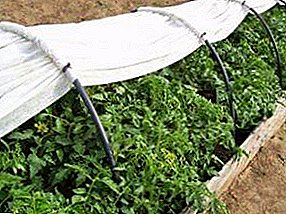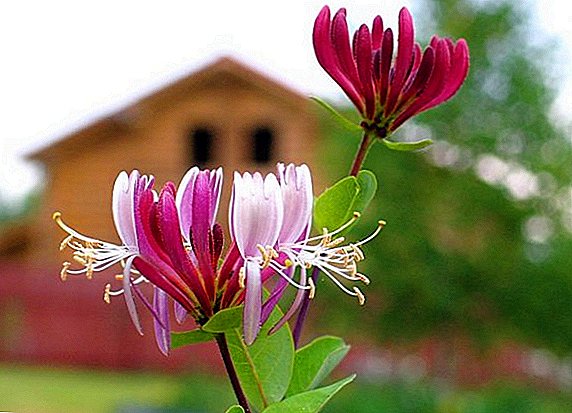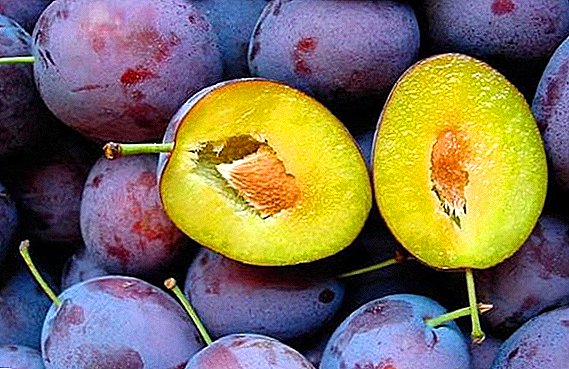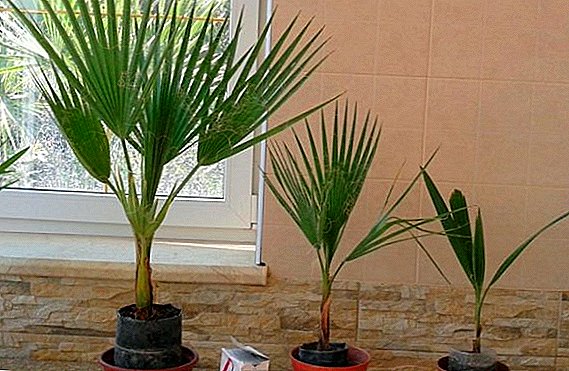 Washingtonia is a perennial palm tree, a real exotic decoration for the interior. This article provides recommendations, with which you can grow a luxurious palm tree, not only in the greenhouse, but also in your own apartment.
Washingtonia is a perennial palm tree, a real exotic decoration for the interior. This article provides recommendations, with which you can grow a luxurious palm tree, not only in the greenhouse, but also in your own apartment.
Botanical description of the plant
Washingtonia is a palm tree whose homeland is Central America. This kind of palm got its name in honor of the first US President George Washington.
The trunk of an evergreen plant can reach thirty-meter growth. The shoot is covered with the remnants of dried leaves. The zone of transition of the roots to the stem may be located in the region of adventitious roots. Large sheet plates - up to 1.5 meters in length; they resemble an open fan, since they are cut to the center point.
Did you know? At home, parts of Washington are used in cooking. Locals grind the seeds into flour, and stalks are boiled or consumed raw.
During the flowering period, the crop forms a bisexual flower, located on a high flower stalk. The inflorescence is a panicle, which at the time of ripening forms dark berries.
Washington Palm Varieties
Scientists know only two types of Washington:
- Filamentous (Cordy, Californian Fan Palm) - A species that creates whole forests in natural habitats. The foliage of this tree is distinguished by a gray-green shade with a multitude of the finest snow-white threads.
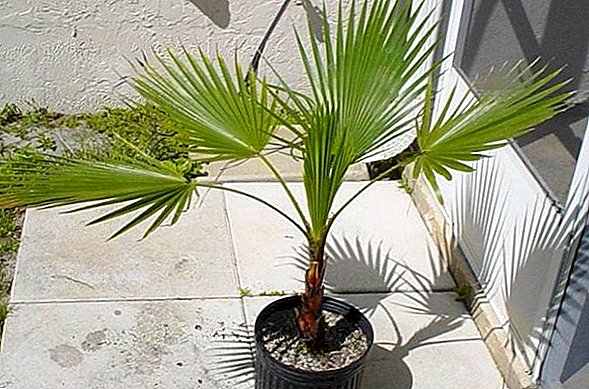
- Robusta (powerful, mexican palm) - tall species, often reaching 30 meters in height. The branched part of the tree is located at the top of the trunk and has a compact appearance. The foliage is intense green, but without white threads. Leaf stalks have thorns.
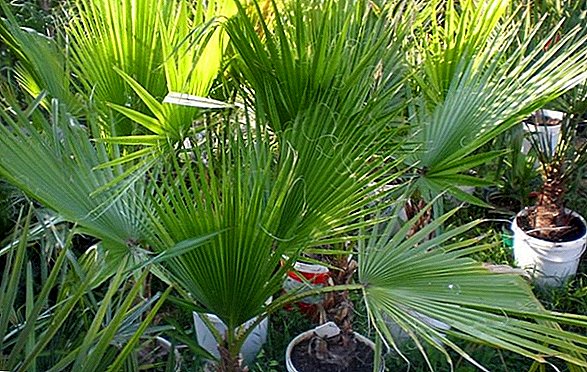
Conditions for growing at home
It is quite difficult to cultivate Washington DC in a house or apartment. The main problems are in the size of the plant and the need to ensure an abundance of light.
Location and lighting
The ideal place in the living room for the content of palm trees - the windows of the east or west. Light is needed bright, but the rays of the sun should be scattered, not straight. On cloudless hot summer days, it is better to take the flower to a more shady corner.
Washington does not stand through winds, but it needs access to fresh air.
Temperature and humidity
In the spring and summer season, the culture needs a temperature of + 20 ... + 24 ° С. On days when the temperature indicator exceeds the mark of + 30 ° C, move the tree to a place with a more acceptable temperature. In winter, when the palm tree stops growing, + 10 ° С is enough for it. And even with the + 5 ... + 7 ° C mode, Washington will feel comfortable.
Did you know? Many nations from ancient times, the tropical palm tree was considered a symbol of victory and peace. Together with a laurel wreath, the winner of the battles was awarded a palm branch.
The plant can tolerate a sufficiently dry microclimate. But at the same time, it reacts positively to spraying the crown and wiping the leaves with a damp sponge, especially in hot weather.
Home care
When caring for the presented culture, be guided by the natural conditions of its growth. In a comfortable environment for itself, this palm tree is actively growing and developing.
Watering rules
Under flat conditions, the palm tree grows best with systematic watering. In summer, the standard mode: the surface of an earthen coma has dried up - the time has come for regular watering. But do not allow waterlogging and stagnation of water. In winter, water the flower two days after the top coat dries.
The most acceptable method of soil moistening is watering from above using a watering can with a long spout. Use warm rainwater, or tap, but defended beforehand. 
Top dressing
In the summer, apply mineral fertilizers at intervals of 1 time in 15 days. Suitable "Akvarin" or "Kemira Lux". You can also use the complexes for palm trees - "Pocon", "Bona Forte".
With the approach of cold, gradually reduce the frequency of dressings. In winter, palm fertilizers are not needed at all.
We advise you to read about the proper care of home palm.
Pruning
Pruning in the case of Washington is not a mandatory procedure. It is used at will, with the aim of slightly slowing down the natural wilting of the foliage. Only dry leaf tips are removed. If the sheet has already become completely yellow, cut it is prohibited.
Transfer
The change of soil is carried out with a special frequency. If the tree is less than 7 years old, repot it every 2 years, if it is more, once in 3 years. If the flower is older than 15 years, then it needs to be transplanted every 5 years. 
Identify the tree in a new pot in late November or early March according to the following scheme:
- Prepare a high pot (low and wide containers will not fit). At the bottom of the pot a high level of drainage is required.
- Add a little substrate (2 parts of sod land, 2 parts of leafy soil, 2 parts of humus, 1 part of sand). In addition feed the soil with organic compounds.
- Carefully remove the flower without breaking the coma of the earth.
- Pass the rhizome into a new pot.
- Add fresh soil mixture on the sides, slightly tamping it.
Important! During the handling process, work carefully, taking care not to injure the roots. And pour over the substrate on the protruding roots during the growth.
Breeding
The only way to get a new Washington DC is seed reproduction. To do this, fresh seed is soaked in distilled warm water for 12 hours. The procedure allows you to speed up the process of punching sprouts out.
Prepared seeds are sown in the nutrient mixture, consisting of equal proportions of moss, sawdust, charcoal and fine sand. Sawdust is steamed in advance to eliminate fungal infection. From above the seeds are covered with the same substrate, a layer about 1 cm thick.
Pot with seedlings covered with a plastic bag and placed in a dark place with a temperature in the range of + 25 ... + 28 ° C. The entire period of waiting for seedlings is kept moist; seedlings are aired every day and protect them from temperature drops and drafts, especially cold ones.
Video: Reproduction of Washington Seeds
If the seed was fresh, the first shoots will appear already on the 8-10 day. Otherwise, seedlings will have to wait more than a month, but you can not wait at all.
With the advent of the first leaves of the seedlings need to dive. Choosing the most healthy and strong copies, carefully transplant them into small vases (10-12 cm in diameter) - each separately. Over time, you will grow a full-fledged palm tree.
Diseases and pests
If the conditions of detention are not observed (with too high dryness, through winds, as well as improper watering), the plant becomes vulnerable to attacks of spider mites, scutes, whitefly, mealybug. If Washington has already been attacked by insects, use the appropriate universal insecticide against each pest. Dilute drugs according to the instructions, to the desired concentration.
Learn how to deal with pests and diseases of palm trees.
The number of ailments affecting the culture in question includes leaf spot and pink rot. In the first case, leaves are affected, the plates can rot from the base. When pink rot wither young shoots. Sometimes rot and formed trunk. Pink spore masses are often observed simultaneously with thick brown liquid.
At the first manifestations of the disease, treat the palm with fungicides containing methyl thiophanate and mancozeb. A break between treatments is one week. Treat the tree until full recovery.

Difficulty growing
To keep room palms from dying, their owners need to know how to solve basic problems:
- Darkening of the tips of the leaves. The trouble is solved competent irrigation and potash fertilizer.
- Despite the correction of care, the leaves continue to darken. In this case, place the indoor palm tree on a tray with water and spray more often.
- The appearance of spots on the foliage. Normalize the temperature in the room where you keep the palm tree. The problem also helps to eliminate the transition to a moderate irrigation regime.
- Periodic withering and shrinking of foliage. Don't worry too much about it. Foliage, dead due to natural drying, must be removed.
Important! It is very important not to miss a serious problem, taking its symptoms for natural wilt. From time to time, check for signs of decay caused by excessive moisture during watering.
If you like exotic plants, definitely try to get Washington. A little trying, you get a spectacular palm tree, which is sure to be the main decoration of the interior of the room.




